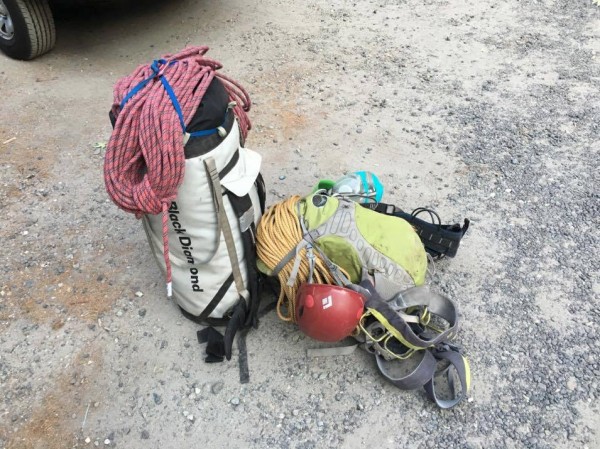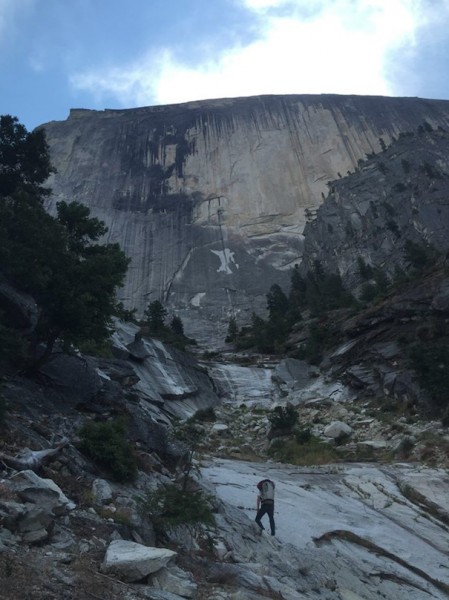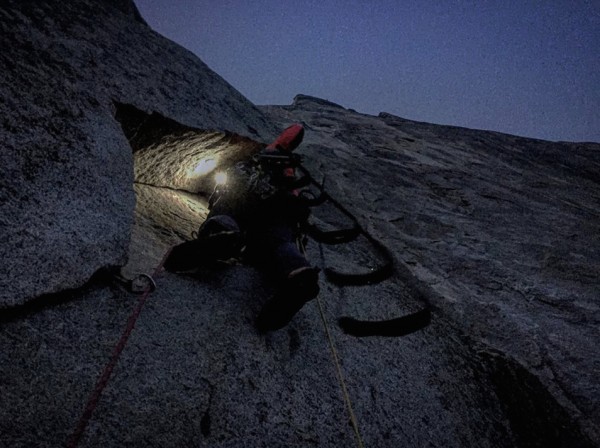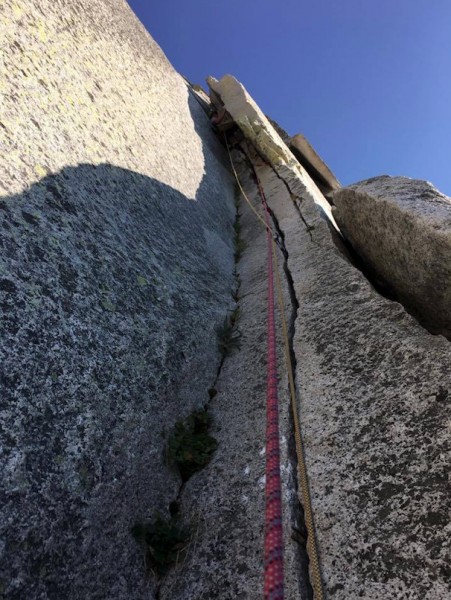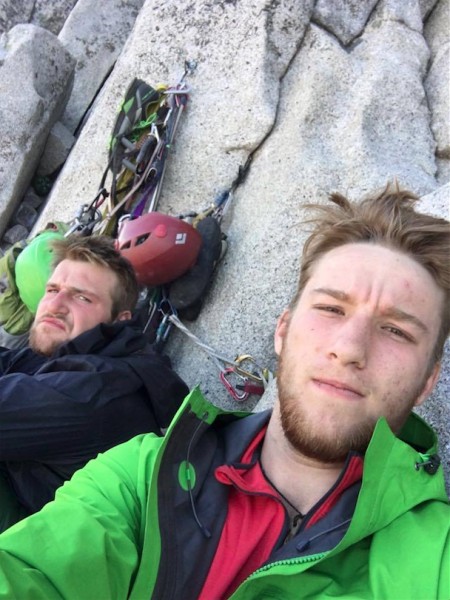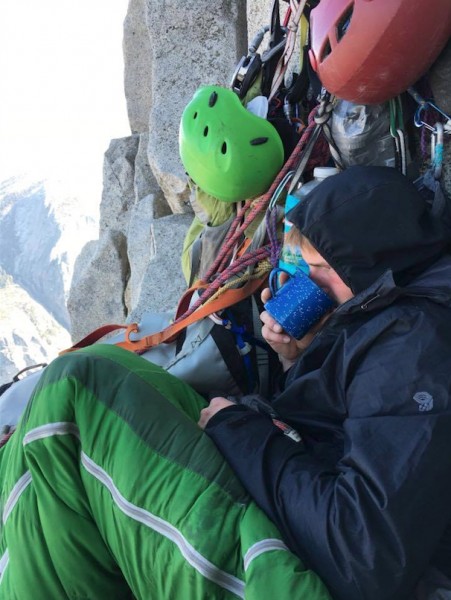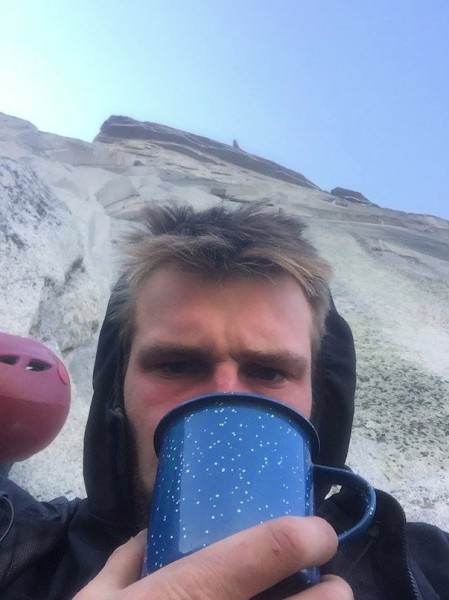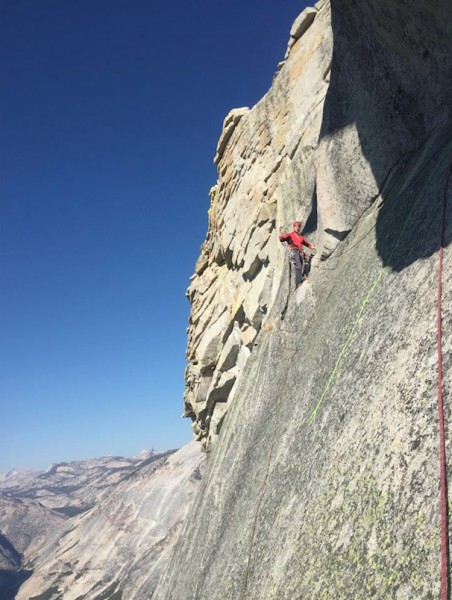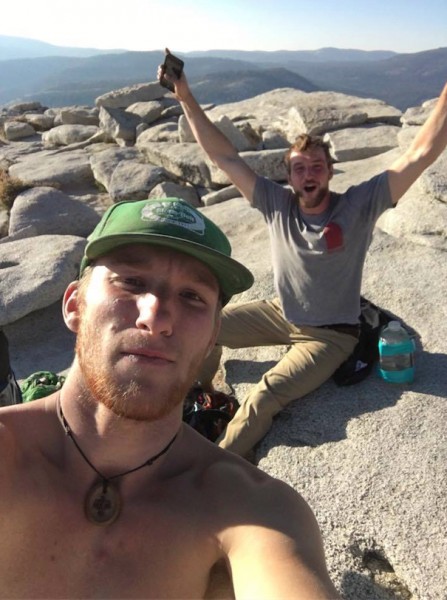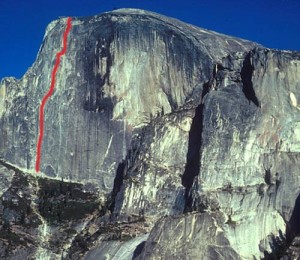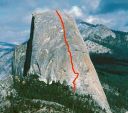Iím sure everyone is good and tired of RNWF trip reports, but I figured this would be a good opportunity to not only preserve my memories of the adventure, but also to provide an update on the conditions of the rockfall zone.
RNWF had been on my mind since last summer. Deterred by the then-recent rockfall and our inglorious retreat off the South Face of the Washington Column, Evan and I came to the cold realization last August that we werenít up to the challenge. We spent the last year upping our free climbing to easy 5.10 and bouldering too much. Evan became a student of the wide while living in Flagstaff, and I made a Solo Ascent of The Prow. By the time August rolled around, we felt that our combined skills would give us at least a decent chance of success.
We spent two days puttering around Camp 4, leery of projected thunderstorms. Our plan was to hike the death slabs and fix to pitch 3 on day one, blast to Big Sandy on day two, and top out on day three. With the bulk of the climbing on the second day, we decided to put off the expedition by 24 hours and risk hiking up in the rain rather than climbing it.
We caught the first shuttle from Camp 4 to the Mirror Lake Trailhead. Finding the correct place to abandon the trail was a bit tricky, but we ultimately found our way through the talus and onto the 4th-class ramp up to the Death Slabs. We made the hike in about five hours and found all but one of the fixed lines in-place (the missing one was easily bypassed with some 5.4 slab). The spring was still running strong, and we enjoyed an hour or two of rest before fixing the first three pitches and admiring the sunset.
Our alarms jolted us from our slumber at 3:30AM. After repacking the pig and the followerís pack (the former only about 60 pounds, the latter only 20), we started jugging our fixed lines. The only bad pig sticks of the climb occurred on the first pitch, when there wasnít a follower to push the pig back on track. We were moving fairly quickly (for us), so I ended up leading the fourth pitch by headlamp. Pitches 5 and 6 were a blur, but we did find a big cache of water on the ledge at the top of Pitch 6. We continued swinging leads up to the top of Pitch 9.
Here, just before noon, we broke for lunch. I also had what was undoubtedly the most miserable bowel movement of my life. My harness doesnít have removable leg loops (rookie mistake), and, in my titanic struggle to get everything in the trash bag, I contorted my poor body into positions that would have made Houdini himself proud. And I used up ĺ of the toilet paper. The bag barely fit in our tiny coffee-can poop tube, the lid of which popped off somewhere around Pitch 15.
I started up the Pitch 10 bolt ladder to start my block. I found the pendulum to the Robbins traverse super mellow, but I was becoming increasingly uneasy about the coming rockfall pitches. I knew about the new rivet ladder and the rope toss, but I hadnít seen any reliable topos online. I figured that this section would make or break the climb for us. Pitch 11 has been cut down to only 50 feet or so by the rockfall, but it was one my favorite pitches of aid to date. It consisted mostly of thought-provoking C2 interspersed with neat 5.9 face moves. At the top of Pitch 11, we found ourselves confronted with new rivet/bolt ladder. About 1/3 of the holes are bolts, so it doesnít feel sketchy in the least. However, the subsequent pendulum was very athletic. I had to get a hard running start and leap for the far left edge of 15-foot ledge. On my third or fourth try, I latched a jug and hand traversed a few feet before committing to the ď5.4 mantle.Ē While the mantle is not technically difficult, the suspect rock and sandy nature of the ledge coupled with the potential for hard pendulum fall made it a somewhat dicey prospect. Here, I decided to set an anchor and break the pitch in half in order to minimize rope drag. The ledge curves upwards until it form the left-facing 11c dihedral. After gardening the crack a bit, the only anchor I could manage in the perfect splitter consisted of all three of our .5 C4ís. There was a fair amount of fixed mank in the dihedral, so I wasnít hurting to bad for the missing .5ís, but I did have to make use of some overcammed .75ís and teetering .4ís. Just as the crack petered out to a thin seam, I was able to reach up and grab some fixed tat hanging from a bolt. After establishing myself on this bolt, I was able to access more fixed tat hanging from another bolt about 10 feet higher. I believe previous parties have reported a single bolt in this dihedral; the lower one may be a recent addition. Evan lowered me out from this bolt, and I wiggled around the corner to see the base of the chimneys. I tensioned traversed for a few feet, and per the recommendations of a trip report I saw on Supertopo, I clipped a cliffhanger to a daisy chain and hooked myself to a large sidepull jug. I then withdrew the secret weapon: 30 feet of 6mm cord with a heavy locker tied on for weight. Eyeing the rope toss, I felt dread settle upon my shoulders. There was no way this was going to work. I took a couple of deep breaths, wound up for the toss, and sunk it on the first go. Whooping with elation, I clipped my jugs to the cord and had Evan lower me out further. After gingerly ascending the cord and committing to an easy mantel, I found myself in the base of the chimneys!
By now, Evan and I were starting to slow down. The combination of the early start and our moronic habit of not eating and drinking enough was starting to wear us down. I handed the sharp end over to Evan, and he cast off into the chimneys to link Pitches 13 and 14. He sauntered up Pitch 13, but ran into consider difficulties on Pitch 14. He opted for the 5.9 squeeze, but it is not particularly well protected. At 6í2Ē and 200lbs, the squeeze was outrageously tight for him. He fought, screamed, and dry-heaved for every inch on what was undoubtedly the most heroic lead of the climb, the whole time yelling at me that ďthis is suicide!Ē while steadfastly refusing to come down. I had a nightmare of a time following this section, even trailing the pack by a sling. In the fray of chicken-wings and kneebars, I somehow dropped one of my ascenders. Luckily, it landed on a small ledge, and I manage to retrieve it.
Only three pitches separated us from our glorious bivy, and Evan scampered up Pitch 15 as the sun was setting. I took over for the last two pitches and led them both by headlamp. Pitch 16 was pleasant 5.9, although some of the flakes were loose. We took along break at the top of this pitch because, well, it wasnít going to get any darker. Iím embarrassed to say it, but I got lost on Pitch 17. After finishing the 5.9 double cracks (best free climbing of the route), I missed the obvious right exit to Big Sandy because of the darkness. I continued up into what the topo suggests is 5.11 terrain (didnít feel that bad to me) and had to traverse and down-climb to Big Sandy. By the time Evan jugged and I hauled the bag, we had been climbing for 19 hours straight. We gorged ourselves on macaroni and cheese and passed out in the wee hours of the morning.
We got a late start the next day. I started up the zig-zags at about 11AM. I aided all three of these pitches, but admired the free-climbing implications the whole time. The aid on the zig-zags is extremely straight-forward: bomber cam after bomber cam.
The Thank-God Ledge was spectacular (of course). A couple days earlier in Camp 4, I had told myself that I would hand-over-hand the entire thing. After 20 pitches of climbing, I was too tired to bolster my ego and ended up crawling most of it.
Pitch 22 was certainly the aid crux of the route. Some tricky free moves are required to get to the first bolt, and a factor-2 onto the anchor is a definite possibility. Getting to the second bolt ladder required some innovation. The topo suggested hooking, but I saw no prime hook placements in the pin-scarred seam of the free line. I tried penduluming into a .3 C4 placement, but to no avail. I ended up tension-traversing into two marginal C3 placements before top-stepping to clip the next bolt. The pendulum point off the second bolt ladder was an old z-ton with a quickdraw hanging from it, but this was easily 8 feet above the last bolt. I couldnít even reach it with a top step, and Iím 6í1Ē. I was barely able to clip it by stepping onto the spreader bar of my ladders.
With the summit in sight and our tribulations nearing an end, I set off on the final pitch of 5.8. Halfway through, though, Evan found himself ensnarled in the worst rope tangle of one rope that I have ever seen (I made an absolute clustercuss of two ropes when I soloed Leaning Tower, but thatís another story). After 15 minutes of swearing, Evan sorted out the rope and I continued up the easy 5th class to the summit ledges.
We shuttled gear to the top and reveled in the summit glory of our biggest, baddest, and best ascent to date. After a few photos and an hour or two of chatting with some German tourists and a British family, we plugged in the headphones and began the long slog down. Because of the dark and our exhaustion, we got a bit lost and wandered into the Ranger Camp by mistake. We accidentally woke up a (justifiably) annoyed ranger who set us on the correct path. It was past midnight when we collapsed into the woods behind the Happy Isles Nature Center. The next morning, we headed to the Pizza Loft for traditional, celebratory large pizzas. And for the first time, we were finally old enough to get beer with them!
Evan has since returned to Flagstaff and is losing skin on more wide cracks. Iím back at school plotting a solo of the Southwest Face of Liberty Cap and dragging whoever I can find up to Tahquitz every weekend. We hope to pull off the Nose come March, and given our performance on RNWF, I think we have a good chance!
Technical Notes:
The hauling on RNWF was not bad at all, but Evan and I are both big galoots (200 and 195lbs), so hauling never feels that bad to us. Our system was to have the leader haul while the follower jugged (or self-belayed for the free sections). This left the follower free to do any necessary pig-wrangling.
I found camhooks completely unnecessary. I never even saw a place to use them, much less actually use one.
We took 15L of water for two big dudes for two days, and we topped out with 1.5L, plenty for hiking down for a refill at Little Yosemite.
We both had sleeping bags, but we cut a sleeping pad in half to save space. We found this comfortable.
Incredibly, we had the entire Northwest Face to ourselves. Iíve read horror stories of 5 or 6 parties in a conga line on RNWF, but maybe the rockfall has scared people away? We saw no one on any of the more serious routes to the right of RNWF.
The rockfall region was all C1 or C1+ aid. The rope toss was nifty, but certainly did not constitute the aid crux of the route. Pitches 22 and 11 were both more involved C2.
A free ascent of the rockfall area would be tricky. The rivet ladder on Pitch 12 goes through the blankest of the blank, and I doubt the rope toss would go free either. The base of the chimney is just sort of hanging in space. We didnít see any good way of free climbing into it, but the team that installed the rivet ladder suggested a circuitous downclimb from the top of Pitch 11.
We used a lot of French-free on this ascent. We didnít free anything harder than 5.10, and we French-freed a lot of the 5.9 and 5.10 (hell, even some of the 5.8) for the sake of expedience.
If you manage to dig out out my #3 C4 from the second zig-zag pitch, then lucky you. Itís been through thick and thin with me, and I hope that its next owner takes it on the adventures it deserves.
Our rack:
000-2 C3ís
.3 C4
Yellow Mastercam
X2 .4 C4
X3 .5 C4
X3 .75 C4
X3 1 C4
X2 2 C4
X2 3 C4
X1 4 C4
1 set of nuts
1 set of micronuts
narrow camhook
wide camhook
grappling hook
cliffhanger
assorted pitons: 2 rurps, 3 beaks, a couple of angles and KBís. These were a backup in case nailing was required to access the pendulum bolt from the thin seam on Pitch 12.
Microtraxion
Cinch
Grigri
Set of yates big wall ladders
Set of black-diamond etriers
2 sets of jumars
9.3mm lead rope
8mm haul line
backpackerís stove (sooooooo clutch)
no offset cams
no beer >.<
